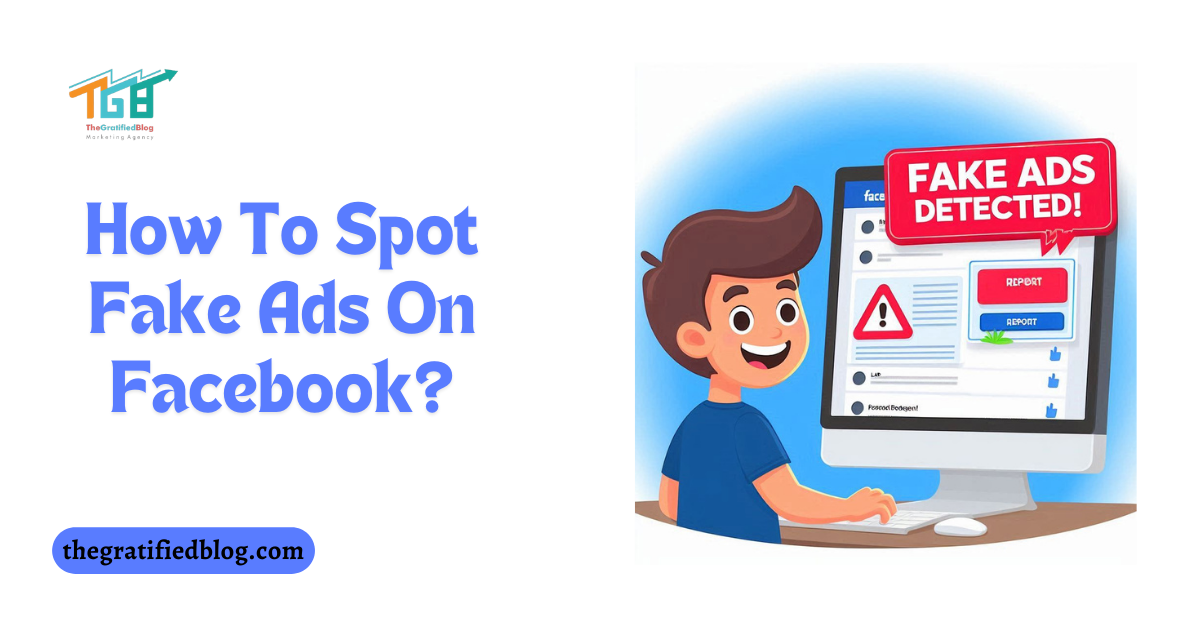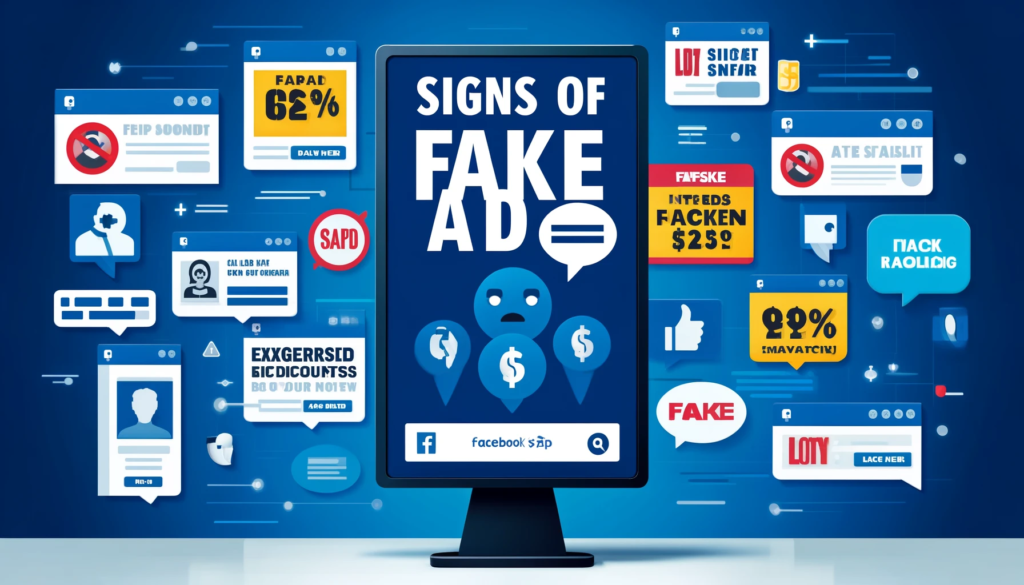
In today’s digital age, social media platforms have become integral to our daily lives, offering various services, from connecting with friends to discovering new products. Among these platforms, Facebook stands out with its extensive reach and diverse user base. However, with the increase in online activities, there’s also been a surge in fake ads designed to deceive and defraud users. Understanding how to spot these fake ads is crucial to protect yourself from scams and ensure a safe online experience. This blog, “How to spot fake ads on Facebook”, will guide you through the steps to identify and avoid fake ads.
What Are Fake Ads?

Fake ads are misleading advertisements that aim to trick users into clicking on them. They often lead to malicious websites or convince users to purchase non-existent products. These ads can appear highly professional and convincing, making it challenging to differentiate them from legitimate advertisements. Fake ads can lead to various issues, including financial loss, identity theft, and malware infections.
Why Fake Ads Are a Problem?
Fake ads are a significant problem for several reasons:
- Fraud and Scams:
Fake ads often aim to deceive users into providing personal information, such as credit card numbers or Social Security numbers, which can be used for identity theft or financial fraud.
- Misleading Information:
They can spread false or misleading information, leading people to make uninformed decisions, purchase counterfeit products, or fall for non-existent services.
- Financial Loss:
Users may lose money by purchasing fake products or services that never arrive or are not as advertised.
- Reputation Damage:
Legitimate businesses can suffer reputational harm if their brands are associated with fake ads, leading to a loss of trust among consumers.
- Security Risks:
Clicking on fake ads can lead to malware or phishing attacks, compromising users’ devices and personal data.
- Undermining Trust:
The prevalence of fake ads erodes trust in online advertising platforms, making it harder for genuine advertisers to reach their audience effectively.
What Are The Signs Of Fake Ads?

Identifying fake ads is crucial to avoid scams and misleading information. Here are some common signs of fake ads:
- Too Good to Be True:
An inconceivable offer is one of the most obvious signs of a fake ad. Be cautious of deals that appear unusually attractive, whether a luxury item at an incredibly low price or a promise of quick and easy money. Legitimate businesses rarely offer massive discounts without a good reason, and such offers should be scrutinized.
- Poor Grammar and Spelling:
Many fake ads are created by scammers who may not have a strong command of the English language. Look for ads with poor grammar, spelling mistakes, or awkward phrasing. While not all fake ads have these issues, they are a typical red flag.
- Suspicious URLs:
Hover over the link in the ad without clicking on it to see the URL. Legitimate businesses will usually have a URL that reflects their official website. Be wary of URLs that look strange, have odd domain names, or are shortened to hide the true destination.
- Lack of Contact Information:
Legitimate ads typically include contact information, such as a business address, phone number, or email address. Fake ads often lack this information or provide fake contact details. If an ad directs you to a website, check if the site has a contact page with verifiable information.
- No Online Presence:
Before purchasing from a new business, do some research. Legitimate businesses will have an online presence, including social media profiles, user reviews, and a website. If you can’t find any information about the business outside of the ad, it’s a major red flag.
- High-Pressure Tactics:
Scammers often employ high-pressure tactics to create a sense of urgency. Phrases like “limited time offer,” “act now,” or “only a few items left” are designed to push you into making a quick decision without proper consideration. Take your time to research and consider the offer carefully.
How To Spot Fake Ads On Facebook?

Spotting fake ads on Facebook requires a keen eye and awareness of common red flags. Here are some tips to help you identify them:
- Check the Source:
- Verify the Page: Look at the page running the ad. Established brands usually have a verified checkmark.
- Page History: Check the page’s history and see when it was created. Newer pages are more suspicious.
- Analyze the Ad Content:
- Grammar and Spelling: Poor grammar and spelling mistakes can indicate a fake ad.
- Generic Branding: Fake ads often use generic branding and low-quality images.
- Examine the Landing Page:
- URL Inspection: Hover over links to see the actual URL. Look for slight misspellings or extra characters in the domain name.
- Secure Connection: Ensure the website hosting has a secure connection (https://).
- Consistency: The landing pages should match the branding and message of the ad.
- Research Reviews and Feedback:
- Look for Reviews: Search for reviews or feedback about the product or service advertised.
- Check Social Media: Look at comments and reviews on social media platforms about the advertiser.
- Be Skeptical of Requests for Personal Information:
- Personal Details: Be cautious if an ad asks for sensitive personal information.
- Payment Methods: Avoid ads that only accept non-traceable payment methods like gift cards or wire transfers.
- Use Facebook’s Tools:
- Report Ads: If you suspect an ad is fake, you can report it directly to Facebook.
- Ad Library: Use Facebook’s Ad Library to see all the ads a page is running. This can give you insights into its legitimacy.
- Trust Your Instincts:
- If something feels off about the ad, trust your instincts and do more research before engaging with it.
How To Protect Yourself From Fake Ads?
Protecting yourself from fake ads requires vigilance and a proactive approach. Here are some steps you can take:
- Enable Ad Preferences
Facebook allows users to control the types of ads they see by adjusting their ad preferences. To do so, go to your Facebook settings, select “Ad Preferences,” and customize your settings to filter out irrelevant or suspicious ads.
- Use Secure Payment Methods
Use secure payment methods such as credit cards or PayPal when purchasing online. These methods offer protection against fraudulent transactions. Avoid using direct bank transfers or providing sensitive information unless you know the website’s legitimacy.
- Keep Your Software Updated
Ensure your device’s operating system, browser, and security software are up-to-date. Regular updates help protect against vulnerabilities that scammers may exploit.
- Educate Yourself
Stay updated about the latest scams and tactics used by fraudsters. Websites like the Federal Trade Commission (FTC) and consumer protection agencies provide valuable information and tips on recognising and avoiding scams.
- Be Skeptical
Always approach online ads with a healthy dose of scepticism. Trust your instincts and proceed cautiously if you sense suspicious activity.
How To Report Fake Ads On Facebook?
To report fake ads on Facebook, follow these steps:
- Go to the Ad:
- If the ad appears in your News Feed, click on the three dots (…) in the upper right corner of the ad.
- You may see the three dots in the corner if the ad appears in the right column.
- Select “Report Ad”:
- Click on “Report Ad” from the dropdown menu.
- Choose the Reason:
- You will be prompted to choose a reason for reporting the ad. Select “Misleading or scam” or any other appropriate option.
- Follow the Prompts:
- Facebook may ask for more details about why you are reporting the ad. Provide as much information as possible.
- Submit the Report:
- Once you’ve provided the necessary information, submit the report.
Using The Facebook Help Center:
- Visit the Facebook Help Center:
- Go to the Facebook Help Center.
- Search for “Report an Ad”:
- Type “report an ad” in the search bar and follow the relevant link.
- Follow the Instructions:
- The Help Center will guide you through reporting a problematic ad.
Using The Facebook Ad Library:
- Go to the Facebook Ad Library:
- Visit the Facebook Ad Library.
- Search for the Ad:
- Use the search function to find the ad in question.
- Report the Ad:
- Click on the ad and look for the option to report it.
Reporting fake ads helps Facebook take action against misleading or harmful content. Your report should be as detailed as possible to ensure appropriate action is taken.
Conclusion
Spotting fake ads on Facebook requires vigilance, scepticism, and proactive research. By understanding the signs of fake ads and taking steps to verify the legitimacy of advertisers, you can safeguard yourself from scams and ensure a more secure online experience. Stay informed, stay cautious, and don’t hesitate to report suspicious ads to help make the online community safer for everyone.








No Comments